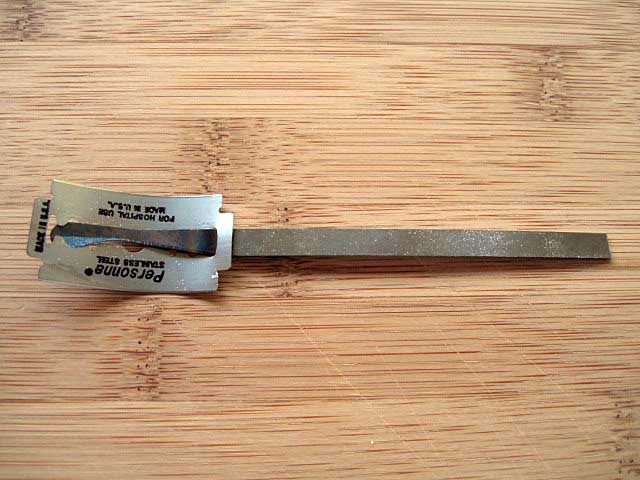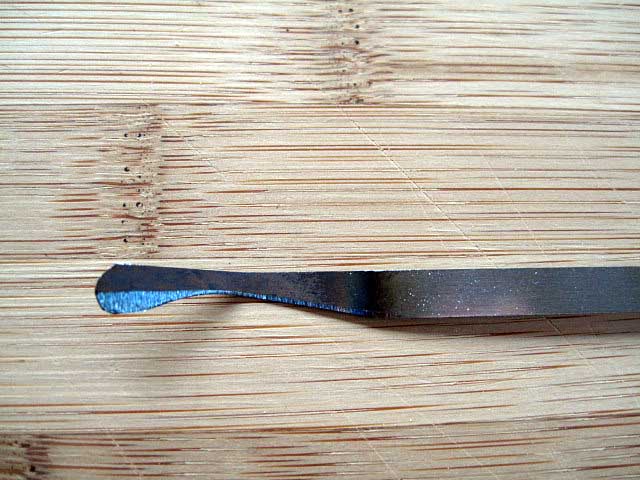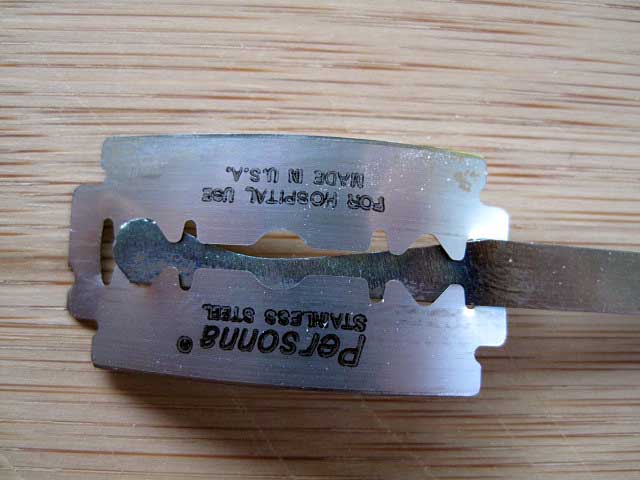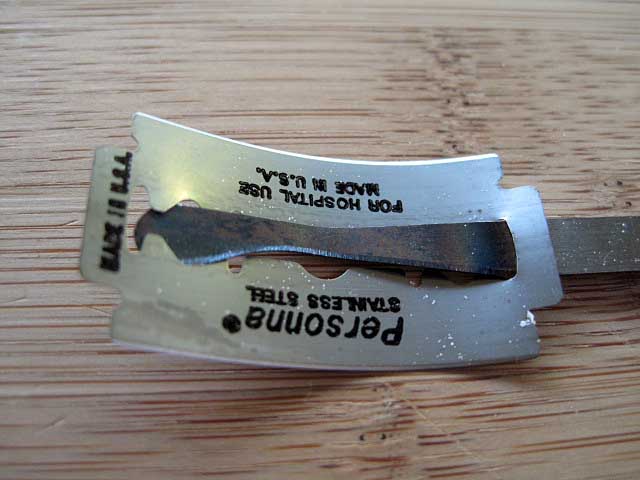Barbara Kraus asked a question about how to get a razor blade installed on the lame handle from TMB (SFBI). I thought some photos would be most informative.

Lame handle with double edged razor blade installed

Tip of handle on which the razor blade gets installed

Close up of installed blade, convex view

Close up of installed blade, concave view
I hope this helps.
David
P.S. To get an idea of the range of lames available to the french baker, check out this web page (recommend doing so while seated): Meilleur du Chef - Lame de boulanger page
Have you found it easier to use than, say, the tomato knife, David?
I've been trying a single edge razor, but there's no wiggle room because the absence of a handle of any sort.
Hmmm. I see "for hospital use" marked on those blades. Are they sharper?
Ease of use is not an issue with either the tomato knife or the lame. The razor blade is sharper. It gets dull faster, but is replaceable. I've just used the lame a few times, but, so far, I am favorably impressed, especially for baguettes.
David
David, if you'll allow me the indulgence to pick an incredibly small nit, what the above photos show is the actual lame itself, not a lame handle, fitted with a double-edged razor blade. I've heard that Prof. Calvel used to travel with a small sharpener so that he could keep his lame sharp, thus not needing to resort to fitting it with the razor blade. Does anybody know where such a sharpener can be found?
SteveB
www.breadcetera.com
Hi, Steve.
I've never dissected a nit ... or a lame.
Is the metal strip on which I inserted the razor blade the lame? I kind of wondered, because the rounded tip has very sharp edges.
If that's the lame, what do you call the lame holding a razor blade? Wait ... Don't tell me! ... I bet it's called "a lame holding a razor blade."
In support of your contention, see the many examples on the linked page in my postscript to the original post. That page does not have any lame sharpeners though.
I have seen a sort of miniature sharpening steel, generally marketed to backpackers. I wonder if that's what M. le Professeur used. Or a stone? Hmmm ... I bet James McGuire knows.
David
I have an itty bitty sharpening stone that I bought with my Felco pruners. It would certainly be travel worthy - if you could get the lame through security...
For useful tools like that I always shop Lee Valley Tools (not affiliated in any way...) they would almost certainly carry a small sharpener for pruning shears. So many usefull tools are so hard to find...
Yes, the round tip is the blade (notice the sharpened edge nearst to the viewer in the bottom picture) - but I have seen the thing used as a blade holder more often than a blade. One thing I like about the metal version of the holder is that you can adjust the curvature to your slashing style - once you get it right, it is sweet. It is also easier to store on a little magnetic strip on a wall or near where you do your slashing so that the thing is always safely and conveniently stored.
My sharpening skills are good enough for the pruner, but when I want wicked sharp a replaceable blade is the best option for me.
Thanks to all for suggestions on ways in which to sharpen a lame. I just did a quick web search and came across a neat little handheld tungsten carbide sharpener that would probably work well on the small cutting edge and curved surface of a lame:
http://www.easysharp.eu/m-english/d-easysharp-xtra
I'll try to find out who distributes their products in the U.S.
SteveB
www.breadcetera.com
It looks like it would open a small bivalve as well as sharpen a small blade.
David
Hi, Pat.
Your comment about carrying a lame onto a plane triggerred a flashback.
My wife has an aunt whose family owned a very chi-chi jewelry store in Palm Springs. As an engagement present, they gave me a gorgeous, beautifully engraved 24 caret gold pocket holder (with clip) for a thermometer. I'm guessing they didn't sell a lot of that item.
Anyway, it is a bit short for holding a lame.
David
That reads kind of funny...
When you travel with the frequency of what I do in what passes for my "normal" life, even the slightest hassle through security can produce odd responses (the stories I could tell...) so I just avoid anything that can be mistaken for a blade.
Or perhaps I am facing down that long flight over the Pacific in the near future. Nice to be going home (for a very short while) - just awful negotiating the flight (s) - it's all so front of mind.
Geez I hope I haven't forgotten how to bake...
We were discussing this over at Forno Bravo a while back after I came across a video of Prof. Calvel using a lame like you describe and as they appear on the web site posted above. It looked a lot like a bent scalpel. If anyone is interested in the video, it is one of Julia Child's old shows from the 70's. She did a short clip with him in France as part of her baguette show. You can get the dvd from NetFlix: The 3rd disk in the series "The French Chef 2 with Julia Child".
His technique is interesting to watch. It had two distinct steps: 1) poke the lame into the loaf, and 2) quickly draw it back. Of course he was very fluid with it :-)
Hi, pdiff.
I haven't seen the Julia Child video, but I purchased the videos that Prof. Calvel made at the CIA. The baguette video shows him using this type of lame, as you described. His movements are magical, indeed.
For anyone interested, here's a link to the CIA series of Calvel videos: CIA Instructional videos (Clavel). Please excuse my misspelling.
David
Hi David,
Thank you so much for the excellent photos, and for taking the time to do this. I really appreciate it. . I think my problem was that I was inserting the lame into the wrong blade openings. The photos really help.
Barbara
That looks great! Now I'll have to get that too :-) Thanks for the resource. It looks like they have many good DVDs there. Are all those bread Podcasts on the DVD? So much to learn.....
On sharpening, I have run my single sided razorblade across a ceramic steel. It was out of necessity as I had no more blades and the one I had was starting to rust (they do this easily). I suppose like any good knife, the lame should be immediately washed and dried.
In wood working I often sharpen the blades of my planes with high grit (1200-2000) wet-dry sand paper on a flat surface with water. It will give you a very sharp, mirror shiny edge google "scary sharp"for more info. I need to try the leather too.
For what it's worth, back in the days before digital image processing, I became skilled at manually airbrushing photos and making masks with very thin paper and rubber cement. The idea was to draw the point of an Exacto knife lightly across the tissue (mask) without cutting the photo below. The blades were reasonably sharp when new but I found I could make them much sharper and smoother along the sides with a few strokes on a smooth stone and a piece of a leather coaster.
The reference to Lee Valley tools above by Proth5 (Pat) would be a good place to find a hard smooth finishing stone but marble would work if you have a small piece. The leather coaster has a smooth side and a rough unfinished side. I start on the rough side with a few strokes then switch to the finished surface to put a nice smooth surface on the edge. An old leather belt would work fine also.
Added by Edit: Here is a link to a page at Lee Valley that identifies a product that would work. A small piece of white marble like stone was included in an inexpensive sharpening set I bought years ago. I'll see if I can find a source priced more reasonably. This is what I would use today with a piece of leather.
When my daughter was in art school, her professor laughed at her for having a sharpening kit in her tool box. I had taught her to sharpen her blades instead of tossing the old ones. Blades cost money which is in short supply for art students. After the Prof started paying attention to how her work was always clean and well cut and the class was coming to my daughter to get a quick tune up on their blades, they all became converts.
Older barbers know how to put a sharp edge on a razor using a leather strop (sp?). I have tried a few times to clean up a double edge razor blade with leather and it does seem to help. You have to be careful how you hold the blade and mind to keep the angle low.
David, I was going to ask you how often you change the blade as a rule.
Eric
I don't know why, with a kitchen full of knives and various knife sharpeners and honers, it never occurred to me to sharpen my blades. What a great suggestion, Eric.
I too am interested in knowing how often people change blades. I have a feeling I don't change often enough, but now that I have an alternative to tossing them, I'm a lot happier.
There is so little meat on a thin double edged razor blade, I don't know how practical it is to renew the edge. I'll play with it and see if I can make a difference. I have a small microscope made for looking at just such things on edge. I'll check back with a report. Blades are cheap.
Eric
At work I'll score on average 120 baguettes and mini (5oz) baguettes per day. So that means somewhere in the neighborhood of 420 cuts give or take. I swap out cutting edges on a daily basis. Remember, though, a double-edged razor blade has 4 cutting edges (top right, top left, bottom right, bottom left). All can be utilized by a combination of removing the blade and turning it 180 degrees and reattaching as well as by turning the blade over and reattaching. So a single blade will last me 4 work days.
Larry
So in essence you get more than 1600 passes from one double-edged razor blade? That's incredible!
If you don't mind my asking, Wally, are you a professional baker?
but learning everyday!
You have an impressive repertoire of sharpening options.
I have a whetting stone I've had for years. I never felt I really mastered it's use. I also have a large marble pastry board. Would that work to sharpen a lame? What's the technique? I assume you hold the blade at a very small angle from the surface. Do you stoke into the surface, drag it backwards, circular motion?
David
David,
I have been a woodworker for many years and before that a model aircraft builder using light weight balsa wood. As any woodworker can tell you, contrary to popular belief, a new cutting tool is only "factory sharp". If one wants to be able to make clean smooth cuts, you must learn to sharpen all of your blades. Carving tools, planer blades, chisels all need to be sharpened with a degree of accuracy that is reflected in the quality of work. There really isn't any point in spending for a nice set of chisels if you plan to every now and then open a paint can with them. My hand tools are "scary sharp" which is what we need in a lame.
The medical grade blades are supposedly made with a better grade of finish and materials to ensure they stay effectively sharp during a procedure. They are a 1 use item as I understand it and are not used on a second patient after being sterilized. I am rather surprised that consumer grade shaving blades are as consistently good as they are. I shave every day and I don't think I have ever had a bad blade right out of the package. That's no easy feat I suspect.
Anyway, on a thin blade like what we use, I draw the blade toward me, sometimes in circular motion. Never into the blade, always from behind. When you get to this degree of sharpening, it's about leaving an edge on the point. The abrasive quality of leather is such that the very fine edge of a blade can be polished to just a few microns. A little compound rubbed into the leather makes a very effective polishing surface. As you know, under a microscope a sharp edge can look rather crude unless it has been polished. A smooth slicing blade will have a polished, mirror like surface supporting the point of the blade. It isn't enough for a blade to be sharp, it also has to be smooth on the sides. A good example of this is the Native fishing guides I have been with in Canada who sharpen their fillet knives on the granite rocks on shore. Dragging the blades across the rough surface they achieve an edge that works on fish and feels sharp but under a close inspection is cut and gouged crudely. Still it works, much like our serrated blades.
Long answer to a short question, sorry. What we would be trying to do is re-establish the edge, not so much sharpen the blade. Similar to using a steel on your chefs knife. A few strokes to straighten out the edge of the blade and remove the damage to the very last few microns is all we can hope for. Your marble would probably work well. Gently and slow drawing motion away from the blade on a wet surface.
I wish I had a way to make a digital image of my microscope viewfinder. It is instantly obvious once you see it.
Eric
David